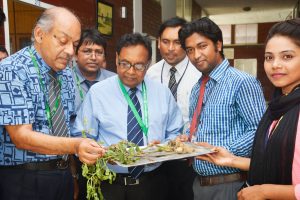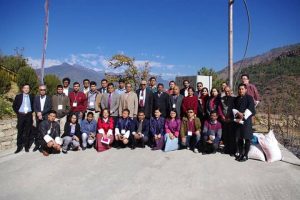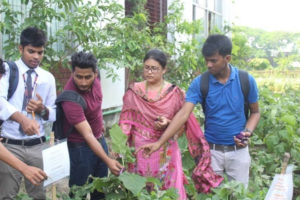Prof Dr Md. Shohidullah Miah: Textile Wastewater Treatment
Title: Involved with research on Textile Wastewater Treatment by using UASB and Bio-filtration process
Concept of UASB Process for Textile Wastewater Treatment:
The anaerobic process is a high quality treatment process. It has several advantages such as low cost, simple operational mechanism and the ability to produce less excess sludge. The organic matter can be converted into energy in the form of biogas. Therefore, the anaerobic process is beneficial in terms of environmental protection and economic viability. In Bangladesh, the anaerobic process is completely new. It can reduce environmental pollution and generate energy in biogas from wastewater. The anaerobic process occurs in the absence of oxygen and converts the organic compound into CH4 and CO2. Therefore, anaerobic treatment is an alternative source of bio-energy and bio-fertilizer as well as reducing environmental pollution. Anaerobic digestion is a promising process for the treatment of wastewater in tropical and subtropical countries. Under the UASB process the organic compounds digested under anaerobic conditions produce: methane, carbon dioxide, hydrogen, nitrogen and hydrogen sulphide, etc.The UASB system is a high rate treatment process. Organic loading rate is the most important for determining the shape and size of the reactor.The UASB successfully uses mesophilic temperature ranging from 25-39°C. The basic concept of UASB is the fact that flocks of anaerobic bacteria will tend to settle under gravity, when applying a moderate up-flow velocity.
This UASB process has been tested at Mascom Composite Limited, Kashempur, Gazipur, Radiance Group Limited, Ashulia, Savar and AmaSyntaxLimited, Kashimpur, Gazipur.

The Beneficial Effects of UASB Process:
i). High rate of anaerobic treatment capacity
ii). Treatment efficiency under mesophilic temperature conditions
iii). High organic strength wastewater can be treated
iv). Relatively simple and low operation costs
v). High organic removal efficiency
vi). Bio-energy benefit can be obtained through biogas production
vii). Excess sludge production is very low compared to conventional treatment processes.
Awards Received
Environmental Certificate Award Received:Dr Md. Shohidullah Miah, Director, College of Agricultural Sciences of IUBAT has been awarded by the Ministry of Environment and Forestry, Government of Bangladesh in recognition of his environmental related research and technology innovation
Attended an International Conference in Thailand:
IGBP-APN write a paper workshop in Thailand August 26-30, 2013, Title of the paper: Climatic and Anthropogenic Factors Changing Spawning Patterns and Production Zone of Hilsa Fishery in the Bay of Bengal.
Videos of successful wastewater treatment by using UASB Treatment process:
- https://www.youtube.com/watch?v=U5xYe26I7h0
- https://www.youtube.com/watch?v=H2A1QvOLUo8
- https://www.youtube.com/watch?v=jdmR2SiBiz4
Proceedings and Journal Publication During at IUBAT
| 1 | Samiha BinteShohid, Rowshan Mamtaz and M.Shohidullah Miah (2018). Review Paper on: UASB Bioreactor for Sewage Treatment, IUBAT Review- A Multidisciplinary Academic Journal, IUBAT Review 2 (1): accepted |
| 2 | MS Miah and Maxim Chakma (2018). Impact of climate change on the male female sex ratios and fecundity of Hilsa (Tenualosailisha) in Bangladesh waters: A Review, 1st International Conference on Challenges in Agriculture, 2018, Page- 55. |
| 3 | SamihaBinteShohid, Md. Shohidullah Miah and RowshanMamtaz (2018). Application of UASB and Bio-filtration Process for Denim Waste Water in Bangladesh, 13th International Globalization Conference.http://www.conference.kglobal.org/index.php/kglobal2018/IUBATkglobal2018/paper/view/1267 |
| 4 | M Shohidullah (2015). Climatic and Anthropogenic Factors Changing Spawning Pattern and Production Zone of Hilsa Fishery in the Bay of Bangle, Weather and Climate Extremes. Volume 7, 109-115. https://www.sciencedirect.com/science/article/pii/S2212094715000031 |
| 5 | M Shohidullah Miah (2012). Cost-effective Treatment Technology on Textile Industries Wastewater in Bangladesh, Journal of Chemical Engineering, IEB, Vol ChE 27, No 1, June 2012. https://www.banglajol.info/index.php/JCE/article/viewFile/15855/11238 |





